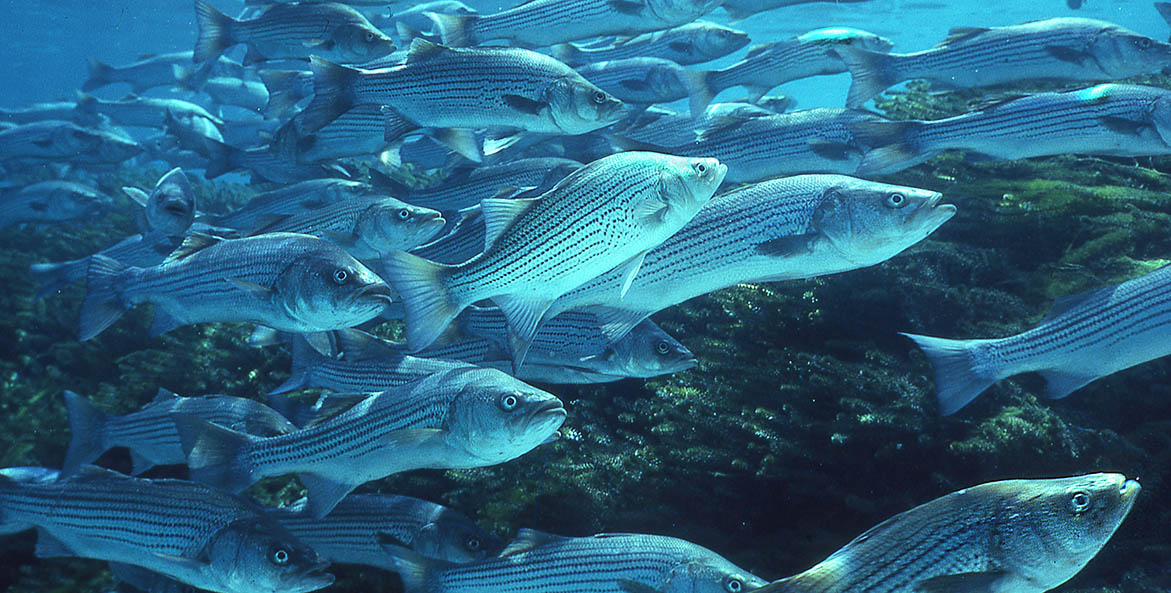Conservation brought striped bass back from the brink. Now, these big, beloved fish are vulnerable once again.
In the fall of 1970, Maryland fishery scientists released a record-breaking assessment. The number of juvenile striped bass in the Chesapeake Bay, calculated through an annual survey of tidal river spawning areas, had tripled from the year prior and was significantly higher than anything recorded in the survey's 16-year history. Just a decade later, the same survey showed juvenile striped bass had plummeted to rock bottom—and stayed there.
"Nothing caught everyone's imagination and excitement and concern more than rockfish did in the 1970s," says Bill Goldsborough, who retired in 2016 after more than three decades as CBF's Director of Fisheries. Thus began one of the most concerted and influential restoration efforts in the history of Atlantic fishery management.
Striped bass, known locally as rockfish, occupy a unique place in the ecology, culture, and commerce of the East Coast. The fish are charismatic by nature. They live more than 30 years, and the big ones that travel into the Bay's rivers to spawn each spring can reach upwards of 100 pounds. After spending the first four or five years of their lives in the rich estuarine waters of the Bay, the young adults swim to the ocean and join the older part of the population that is prized everywhere it goes.
"Rockfish migrate in the waters of a dozen different states, from North Carolina to Maine," says Goldsborough. "And it's probably the favorite fish in all of those states."
After the scare of the 1970s, actions to rein in overfishing through the 80s and 90s achieved resounding success, and striped bass recovery became a blueprint for managing and restoring other fisheries along the East Coast. Now, the warning bells are ringing again.
The most recent scientific stock assessment, released in 2019 by the Atlantic States Marine Fisheries Commission (ASMFC), found striped bass are overfished and the coastwide population is well below target levels. In the Chesapeake Bay, not only has there been a lack of legal-sized fish, but there has also been below-average spawning activity, and the number of large, female fish has been declining for over a decade. These trends led to a 17-point drop in CBF's 2020 State of the Bay score for rockfish, one of 13 indicators CBF scientists use to gauge the Bay's overall health.
What's going on? Getting a handle on overfishing was the primary goal of earlier striped bass conservation efforts, and it remains an essential part of the population's recovery. Even stress and injuries from being caught and released can result in an unfortunately high number of dead fish each year. Equally concerning this time, though, are ecological threats to striped bass.
Striped bass spawn and spend their most vulnerable life stages in the tidal reaches of Bay rivers, where fresh and saltwater meet. These areas are often the most exposed to pollution running off the nearby land, and to human activities that can disturb the fragile environment. In the Bay's mainstem, low-oxygen dead zones, driven by excess nitrogen and phosphorus pollution in the Bay, can stress striped bass and push them into warmer waters than they prefer, making them more susceptible to diseases like mycobacteriosis. And concerns around the health of the menhaden population, a primary prey species for striped bass which are harvested by an industrial fishing fleet in the Chesapeake Bay, remain.
Climate change, including increases in water temperature and changes in rainfall patterns, is a growing concern for striped bass throughout their life cycle in the Chesapeake Bay. Warmer waters may be leading to reduced spawning success, reduced growth of young striped bass, and increased disease prevalence in the striped bass population. Climate change is also a major worry for the restoration of the Bay's underwater grass beds and oyster reefs, both of which provide critical habitat and hunting grounds for striped bass.
"We're lightyears beyond where this challenge was in the early 80s. We have so much more data and science and management ability and authority, that I continue to have faith that we're going to pull this off," Goldsborough says. "But that doesn't mean you can relax. You have to get in there and make it happen."
The Atlantic States Marine Fisheries Commission (ASMFC), the interstate body that manages striped bass coastwide, is currently updating the striped bass fishery management plan and is seeking additional input from all parties—including you—who care about rockfish. This is an important opportunity to help shape the long-term future of this critical fish. More importantly, this is your opportunity to let ASMFC and state fishery managers know what should be included in the next management plan. Specifically, we're asking ASMFC to:
- maintain the management triggers that guide decisions and actions to reach a stable population;
- ensure more rockfish survive catch-and-release;
- respond quickly to the results of the forthcoming population estimate; and
- revise the Conservation Equivalency Program—which allows each state to set its own unique regulations to manage rockfish while still aiming to meet ASMFC fishery management plans—to ensure the actions states are taking are effective.
ASMFC states will be hosting public hearings during the month of March, and we strongly encourage you to attend if possible.




